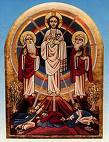Thoughts after visitation: Architecture
I have been back in the States for just over a week, having participated in two visitations in England. The experience was a very edifying one, full of good lessons in monastic life. I would like to share with you three of these lessons.
First: architecture shapes community
Note that I did not say that architecture determines community. In Chicago, we live in a former parish rectory. It is a very poor cloister from the monastic point of view, but with a certain effort and imagination, we can still live a fairly normal monastic life. On the other hand, we cannot survive here long term: there are too many areas where this effort and imagination can't be sustained, and a real cloister will shape our imagination and relieve some of the effort.
At Farnborough, they have an absolutely lovely nineteenth-century New-Gothic church. Furthermore, they have gorgeous vestments and accoutrements for the altar. In reading over their history, it was quite a surprise to me that as recently as 1995, they were running a parish and singing a modern style of liturgy. This is not a criticism: the bishop asked them to do the parish, and as is the case with monks with an apostolate, the full divine office was no longer possible. However, this whole experience of a liturgy that did not fit the space and other stresses associated with the new apostolate caused the community considerable grief. In recent years, they have been moving back to a more contemplative existence, and the sense of relief and appropriateness is almost palpable.
At Prinknash, the community preparing to move back to "The Grange"--a building that was once a medieval hunting lodge, then transformed into a monastery, then a guest house. The community was booming in the 50's and 60's and simply could not fit in the Grange. So they planned a new church and cloister (much as our community is today). The original plans were to accomodate 250 monks--a not unreasonable amount at the time. For a variety of reasons, they were not able to finish the project. They have been praying in hat was to havebeen the church crypt ever since. While it is a warm and suitable space, it still feels a bit like a crypt.
The beginning of the building project coincided with the almost-universal decline in monastic vocations in the 60's and 70's. Thus, the community moved into a large space just at the time that numbers went into decline. Today, they are a community of thirteen, planning to move back to the smaller 'hunting lodge'. This decision is welcomed by the community as a whole in a very positive way. The problem with the current large cloister is more than economic: the men living there make up a good, solid community. However, one almost never sees them because of the building's expanse. In a smaller space, the fraternal charity that exists will be more evident.
In this case again, architecture ended up working against the community's goals. In the case of Farnborough, they made changes to the life and kept the buildings; in this case, they are keeping the specifics of the life and therefore need a different building. In our case here in Chicago, we have a bit of both: our liturgy, when we came from La Communaute de Jerusalem in Paris, had a Byzantine flavor to it. Little by little, we have found that our church is much better suited to a traditional Latin liturgy. On the other hand, we have reached a point of community growth that our living spaces are not suitable, causing us to be at cross-purposes with them. So we need to move, presumably into a building not yet constructed.
Tomorrow: Lesson 2: The Importance of Community History

No comments:
Post a Comment